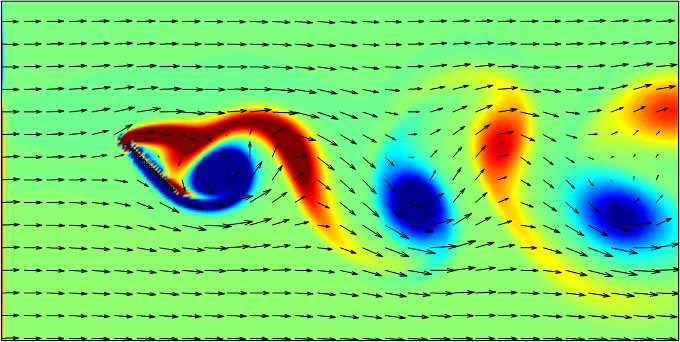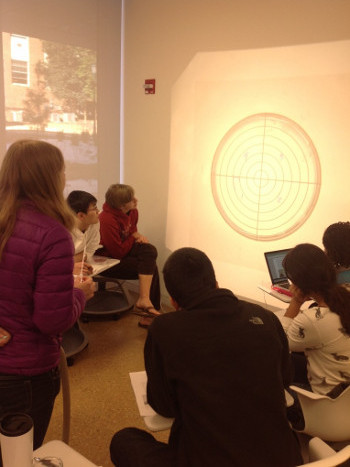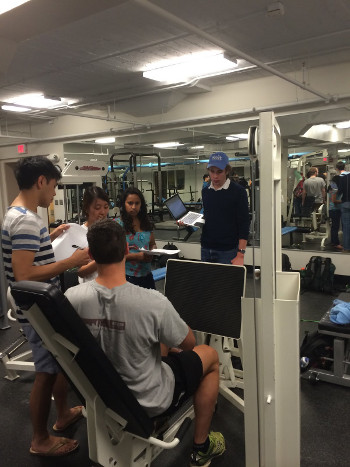SICB Annual Meeting 2015
January 3-7, 2015
West Palm Beach, FL
Society Wide Symposium: Leading Students and Faculty to Quantitative Biology Through Active Learning

Simulation of flow past a plate in two-dimensions with applications to swimming and flying.

Students quantifying brine shrimp movement by projecting a Petri dish.

Students measuring their own force-velocity curves at the
UNC Recreation Center
Goal: To present new activities and approaches that introduce students to quantitative biology through active learning.
Rationale: In the last 20 years, many science organizations have recognized the benefits of active and inquiry-based learning and called for changes to the way undergraduate biology is taught. The Boyer Commission led a study that considered the effects of various teaching strategies on all academic disciplines. They recommended that faculty provide more research-focused, interdisciplinary opportunities in the classroom. In recent conference organized by the AAAS (Vision and Change: A Call to Action), active, collaborative, and inquiry-driven teaching techniques were outlined as an alternative to the current problems in teaching biology to undergraduates. Citing recent advances in the understanding of learning and retention, the report recommended that passive lectures be replaced by engaging students in active learning that structures around the work of diverse groups [1,2]. These methods engage pathways beyond listening to reach a broad range of students who learn in different ways.
Exercises in mathematical modeling can specifically address many of core concepts outlined in Vision and Change in a way that promotes the changes in pedagogy at the heart of the recommendations. Individual exercises would not only address core concepts such as structure and function of organisms and evolution directly through modeling exercises that investigate these topics, but they would do so in a way that clearly articulates the principles of scientific process. Furthermore, the potential for quantitative tools to advance our understanding of grand challenge problems in the life sciences has received much attention over the past 10 years. The effective training of life science students in mathematics and statistics is critical to this mission, and both the biological and mathematical communities are in need of more material.
Website: http://teachmathbio.web.unc.edu/
Sponsors: SICB Wide; DAB, DCB, DCPB, & DVM; ARO Biomathematics
Organizers
- Laura Miller, University of North Carolina at Chapel Hill, lam9@unc.edu
- Lindsay Waldrop, University of North Carolina at Chapel Hill, lwaldrop@email.unc.edu
Speakers
S9.1 Tuesday, Jan. 6, 07:30 MILLER, Laura A*; BATTISTA, N; GRIFFITH, B:
A quantitative biology lab to compare simulations of crossbridge attachments to force-velocity and length-tension curves in skeletal muscle
S9.2 Tuesday, Jan. 6, 08:00 FULL, R.J.*; DUDLEY, R.; KOEHL, M.A.R.; LIBBY, T.; SCHWAB, C.:
The Impact of Discovery-Based Instruction on Interdisciplinary Research Skills
S9.3 Tuesday, Jan. 6, 08:30 DREW, J.A.:
Using technology to expand the classroom in time and space
S9.4 Tuesday, Jan. 6, 09:00 KOHLER, B. R. *; BRUDER, A.:
Limnology and Inversions in Multivariable Calculus
S9.6 Tuesday, Jan. 6, 10:30 DINIZ BEHN, CG*; LOPP, S; GLEIT, RD; BOOTH, V:
Who needs sleep? Engaging students in mathematical modeling of sleep and circadian interactions
S9.7 Tuesday, Jan. 6, 11:00 WALDROP, LD*; PRAIRIE, JC:
Using small, interdisciplinary groups to engage students as participant-scientists in mathematical biology
S9.8 Tuesday, Jan. 6, 11:30 ADLER, F. R.:
Using simple models to motivate mathematics and understand cancer: Making the classroom into a workshop for collective model development
S9.9 Tuesday, Jan. 6, 13:30 PEPPER, Rachel E.*; CHASTEEN, Stephanie V.; POLLOCK, Steven J.; PERKINS, Katherine K.:
Applying the results of education research to help students learn more
S9.10 Tuesday, Jan. 6, 14:00 GROSS, Louis J.:
Preparing “Fearless” Biologists: Quantitative components for undergraduate life scientists
S9.11 Tuesday, Jan. 6, 14:30 SHTYLLA, Blerta:
Interdisciplinary team approaches to mathematical modeling in a liberal arts setting.
S9.12 Tuesday, Jan. 6, 15:00 ADOLPH, SC:
Transforming classical models and original research into active learning activities in quantitative biology

